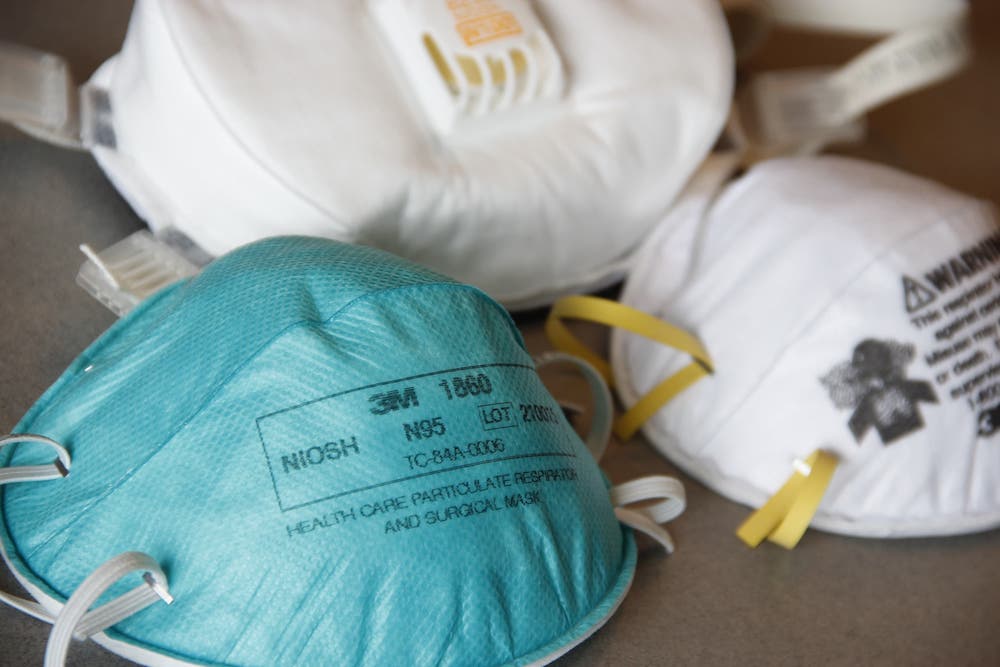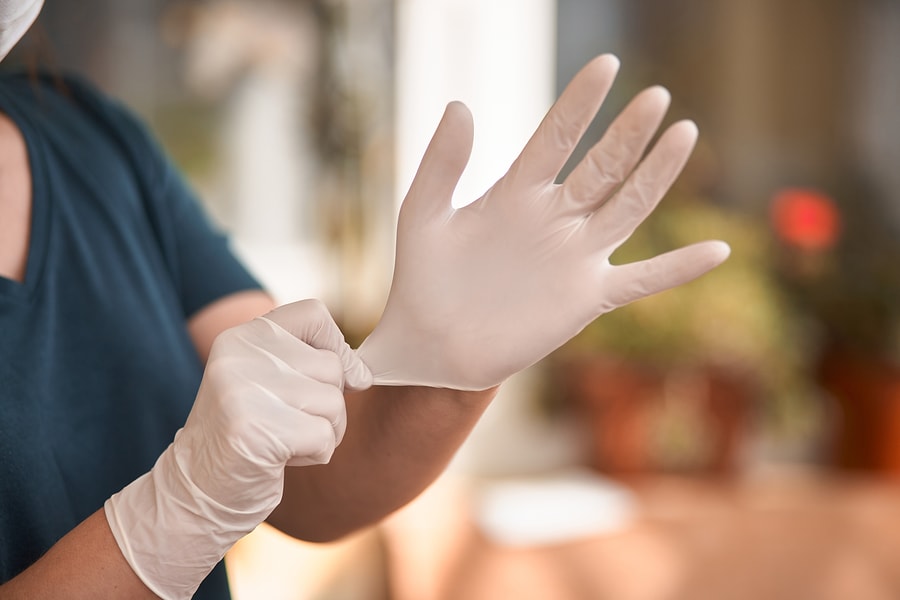How to Keep Germs Out with PPE
A Guide to Properly Wearing PPE on the Job
Unless your employer requires the use of face masks and surgical gloves to stop the spread of germs and viruses, you probably aren’t familiar with wearing PPE for hygienic purposes while on the job. In light of Covid-19, these kinds of precautions will likely be the new normal when returning to any place of work. Taking the proper precautions, advised by the CDC, can greatly reduce the spread of germs and viruses, creating a safe and healthy work environment and ensuring your business can run smoothly.
Let’s talk about how to properly incorporate hygienic practices into your daily routine, how you can make sure they’re effective, and what to do when you’re done working.
Masks — Why, How, and What to do After
 Sanitary masks are a major part of keeping germs out, your own germs to yourself, and preventing the spread of any harmful pathogens. Wearing a mask can be the difference between getting sick and staying healthy. So, how do you wear a mask properly if you’re used to wearing fall protection gear and not sanitary masks?
Sanitary masks are a major part of keeping germs out, your own germs to yourself, and preventing the spread of any harmful pathogens. Wearing a mask can be the difference between getting sick and staying healthy. So, how do you wear a mask properly if you’re used to wearing fall protection gear and not sanitary masks?
How to ensure a proper fit for your sanitary mask:
- Mask should be the first layer on your head for a close fit.
- Wrap straps around ears or back of head and neck.
- Have a snug fit so there are no gaps between the mask and your face.
- Filter of the mask should stretch from below your chin to the bridge of your nose.
- Metal bracket should be on the nose, not down at the chin.
- Facial hair where the mask meets your face will compromise the seal. A clean shave is ideal for the effective use of respirators.
- Homemade cloth masks should follow the same guidelines. Check out a tutorial and other considerations for cloth masks from the CDC.
When you do remove your mask, make sure to do it gently and try your best not to touch the mask itself or the filter. Doing so would spread whatever is on the mask to your hands and can be a potential hazard until washed thoroughly. Instead, grasp the straps of the mask and carefully remove it and dispose of it immediately.
Some masks are made to be reusable, such as homemade cloth masks and respirators, while disposable masks are made to be used once and only once. Surgical masks and masks such as the N-95 are functionally considered disposable. However, due to shortages and the need for N-95 masks in healthcare, the CDC has a list of methods that could be used to decontaminate N-95 masks for reuse. The simplest of which is to use multiple masks that are only worn once a week in a rotation. This gives any pathogen on the mask time to die off.
Benefits and Drawbacks of Different Masks Types
| Homemade Masks | Surgical Masks | Disposable Respirator Masks | |
|---|---|---|---|
| Intended Use | Varies depending on craftsmanship. Helps keep some particles in and out. Social distancing is crucial. | Fluid and splash resistant to protect against large droplets. Best used to keep your own germs to yourself. | Small particle aerosol protection to oily-based particle protection. Ranges from 95% filtration to 99.9%. |
| Face Seal Fit | Loose depending on craftsmanship. | Loose around cheeks and nose. | Tight seal along edges of mask. |
| Use Limitations | Cloth masks can be washed and sanitized for reuse. Not officially tested for safety from airborne contaminants. | Not reusable. Must be disposed after every use. Does NOT protect against small particle transmission. | Discard after every use. If seal does not form or mask is damaged, dispose of it. *CDC suggests reuse due to mask shortage. |
Glasses or Goggles - Which is Best to Stay Sanitary
 Safety glasses and goggles are critical PPE to protect your eyes from particles, dust, chemicals, and other hazards on the job. However, glasses and goggles will help keep your hands away from direct contact with your eyes. This simple step can keep viruses, bacteria, and germs out of your body so you can stay healthy. The big difference is that goggles will make a seal around your eyes, preventing airborne substances from getting in. Remember, you want to protect your eyes from physical damage, but they are also an opening to invisible threats to your health.
Safety glasses and goggles are critical PPE to protect your eyes from particles, dust, chemicals, and other hazards on the job. However, glasses and goggles will help keep your hands away from direct contact with your eyes. This simple step can keep viruses, bacteria, and germs out of your body so you can stay healthy. The big difference is that goggles will make a seal around your eyes, preventing airborne substances from getting in. Remember, you want to protect your eyes from physical damage, but they are also an opening to invisible threats to your health.
Disposable Gloves — Helpful to Keep on Hand
We often wear work gloves to keep our hands protected from sharp materials, provide additional grip, or protect from other elements such as heat or cold. But did you know that many cloth or fabric work gloves are actually porous and can allow water and contaminants to contact our skin? A simple way to keep your hands sanitary and away from direct contact is to wear disposable gloves underneath your work gloves, such as latex, nitrile, or vinyl.  When the job is done, it’s critical to remove the gloves correctly. You’ll need to peel the gloves off from the cuff, turning them inside out as you remove them. Check out this guide to removing your gloves from the CDC.
When the job is done, it’s critical to remove the gloves correctly. You’ll need to peel the gloves off from the cuff, turning them inside out as you remove them. Check out this guide to removing your gloves from the CDC.
Whether you wear gloves or not, washing your hands and keeping your hands away from your face is the best way to prevent any harmful bacteria or viruses from entering your body.
After Use:
Whatever precautions you take on the job, don’t take any chances that’ll risk bringing harmful substances into your home. If you can, remove your gear at work and leave it there. If you’re not able to leave it all at the site or at an office, try leaving it in a vehicle where you won’t need it until the next time you work. If you do bring your gear home, keep the PPE outside in a safe spot; in a garage, a shed, or a container where it can be stored away and out of reach. You don’t want to have any infectious bacteria or viruses in your home, especially if you have any family or housemates that could come into contact with it.
It’s vital to sanitize any equipment that is used frequently or shared on the job. Use sanitary wipes or soap, warm water, and a rag to sanitize anything that you can. If you’re not sure, check out this blog on how to effectively clean and disinfect your equipment. Most importantly, wash your hands and any exposed skin before coming into contact with anyone. Preferably, shower up (or take a bath if that’s your thing).
On an even more serious note, days can be long. We know how big the desire is to get home and hug the ones you love. Don’t take a risk, don’t rush anything.
RECAP
In light of the Covid-19 outbreak, it’s critical to prioritize safety by taking precautions to reduce your risk of illness or injury on the job. It’s important that you select the right equipment for the task at hand, ensure that it fits you properly and that whatever equipment you use is undamaged. Failure to address these considerations can compromise the effectiveness of your PPE and result in serious injury or exposure to harmful substances. Having the right precautions in place can ensure the health and safety of you and your team and keep your busy running smoothly should an emergency happen in the future.
For more information on sanitary measures and how to mitigate the risk of Covid-19, visit the CDC website.

